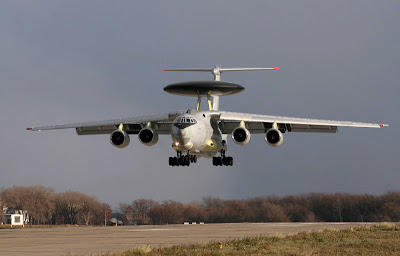 |
| Indian Phalcon AWACS |
In India Clearances are underway to initially develop two AWACS aircraft,
with four more to follow at a later stage, under the new `AWACS-India'
project to be executed by DRDO and its Bangalore-based Centre for Air
Borne Systems (CABS).
Under it, 360-degree AESA (active electronically scanned array) radars will be mounted on large aircraft like IL-76, Boeing or Airbus said a DRDO source.
Potent force-multipliers like AWACS or AEW&C (airborne early warning and control) systems have changed the entire nature of air warfare because they can detect incoming aerial threats, ranging from fighters to cruise missiles, much before ground-based radars.
They also serve to direct air defence fighters during combat operations with enemy jets and also help in tracking troop build-ups.
Pakistan already has four Swedish Saab-2000 AEW&C aircraft, with four more Chinese ZDK-03 AWACS in the pipeline. China has around 20 AWACS, a mix of new and old systems, say sources.
But IAF has only three Phalcon AWACS mounted on IL-76 aircraft, under the $1.1 billion tripartite agreement among India, Israel and Russia finalized in 2004, despite being confronted with two potentially hostile fronts.
The case for two additional "follow-on" Phalcon AWACS, with a range of over 400-km and 360-degree coverage like the first three, has run into some rough weather due to sharp cost escalation.
Moreover, DRDO's ongoing mini-AWACS project, under which indigenous AEW&C systems are to be mounted on three Embraer-145 jets obtained from Brazil for $210-million, has also slipped after being approved in October, 2004, at a cost of Rs 1,800 crore.
DRDO, however, contends the project is now on track. "CABS will get the first Embraer, modified with antenna units and other structures mounted on its fuselage, in July," said an official.
"All electronic systems, with a normal radar range of 250-km and a 240-degree coverage, will then be integrated. The first flight should take place in early-2013. The project completion date is April 2014," said an official.
IAF is awaiting the completion of the mini-AWACS project as well as the launch of the larger 'AWACS-India' programme with crossed fingers. AWACS also constitute a crucial constituent of its IACCS (integrated air command and control system) programme, the fully-automated network being set up to integrate the wide array of military radars with each other as well as with civilian radars to plug surveillance gaps in Indian airspace.




No comments:
Post a Comment